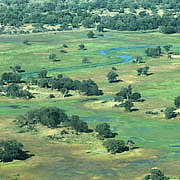Database of wetland experts
IUCN Regional Office for Eastern and Southern Africa, the International Water Management Institute (IWMI) and the Food and Agriculture Organization (FAO) are the executing agencies for a United Nations Environmental Programme (UNEP) project on “Sustainable Management of Inland Wetlands in Southern Africa: a livelihoods and ecosystems approach.” The goal of the project is to “generate knowledge to assist in sustainable management of wetlands” and the objective of the project is “to increase capacity for management of wetlands in both government and non-governmental agencies in southern Africa through generation of new knowledge on wetland functioning, and development of sustainable land management options for wetlands”.

Photo: Eliot Taylor
IUCN Regional Office for Eastern and Southern Africa, the International Water Management Institute (IWMI) and the Food and Agriculture Organization (FAO) are the executing agencies for a United Nations Environmental Programme (UNEP) project on “Sustainable Management of Inland Wetlands in Southern Africa: a livelihoods and ecosystems approach.” The goal of the project is to “generate knowledge to assist in sustainable management of wetlands” and the objective of the project is “to increase capacity for management of wetlands in both government and non-governmental agencies in southern Africa through generation of new knowledge on wetland functioning, and development of sustainable land management options for wetlands”.
Southern Africa is well endowed with wetlands of varying types. These range from the smallest systems such as dambos to very large flood plains and marshes such as the Okavango Delta in Botswana and the Bangweulu swamps in Zambia. The major types of freshwater ecosystems are rivers, lakes, flood plains, swamps/marshes, and a variety of seasonally wet areas such as dambos and pans. Some of the well-known natural wetlands of the region include the Okavango delta (Botswana), Makgadikgadi Pans (Botswana), Barotse swamps (Zambia), Bangweulu swamps (Zambia), Kafue flats (Zambia), Linyanti-Chobe Swamps, (Botswana & Namibia), Zambezi delta (Mozambique), Etosha pan (Namibia) and St Lucia wetlands (South Africa). The diversity of flora and fauna of wetlands in the region is immense and in many places unknown, with endemic and rare plant species and wildlife, including migratory bird species.
Wetland ecosystems in southern Africa support important populations of wildlife and provide numerous products such as fresh water for human, livestock and wildlife consumption, fertile soils for agriculture, and the yielding of a major harvest of fish protein. In addition to the provision of these essential products, wetlands perform numerous ecological and hydrological functions, such as groundwater recharge and discharge, flood and erosion control, sediment and nutrient retention. Research has established that inland wetlands constitute a key resource sustaining community livelihood (especially food security) in all the SADC countries.
One of the activities of this project has been to gather information on wetlands experts in the SADC region and formulate this information into a database.
Feel free to download and use the database, and if you are able to contribute any updated information, please contact the South African office on iucnsa@iucn.org



